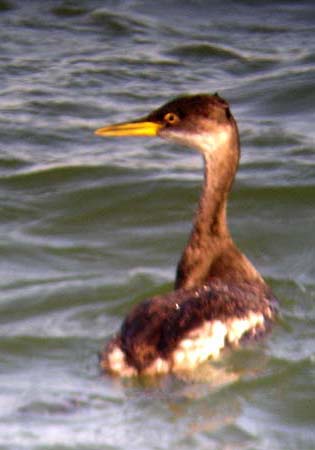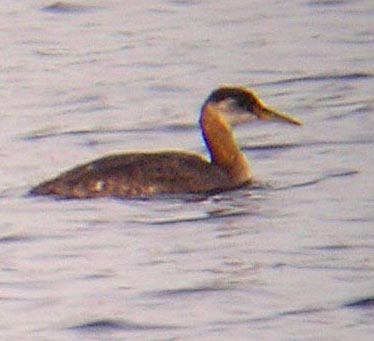 |
 |
 |
 |
| This Holarctic grebe is a scarce winter visitor along the coast of
Monterey County (MTY). We are near the southern edge of its wintering range
and only a few are found each winter. Most arrive in late October or November
and remain to March or April. The individual shown (above) was digiscoped
in the channel between the two jetties at Moss Landing harbor on 20 Nov
2004. This is one of the few regular spots to look for this species in
MTY and also one of the few where you can get close views; otherwise, this
grebes is rather shy and hard to approach. This seems to be a first-year
individual with browner plumage than winter adults (note thin reddish tips
to back feathers that help to age this bird), and Rita and I were surprised
by its very bright yellow bill and bright yellow eye.
Note the extensively dark neck, the dark fact, and the 'hook-back' pattern where the white throat and upper neck hooks back toward the eye above the darker auriculars (especially in the right-hand photo, above). This pattern is discussed in European field guides (e.g., Mullarney et al. 1999). Photos above © D. Roberson |
 |
In contrast, the first arriving adults in late autumn may retain portions of breeding plumage (left; this one digiscoped in Monterey harbor 15 Nov 2004; © D. Roberson). The neck is still quite red, the cheeks white and the crown black, and the bill still yellow. This bill color, and the alternate plumage, will soon be lost. However, the grebes that are still around very late in the winter — especially in April or early May — are often well into full alternate plumage before they depart. Some of these may be migrants that wintered a bit farther south. |
| In winter both adults and youngsters acquire basic (=winter) plumage that is much more gray and white in tone (two photos below). Contrasting white cheeks are often (but not always) present (e.g., Palmer 1962, Cramp & Simmons 1977). Bill color becomes much duller: pale gray or ivory. The bill is medium in heft: not short or thin like the smaller Eared or Horned Grebes, but not as long and dagger-like as the larger Aechmophorus grebes. |

Photo Feb 1987 Moss Landing © Robert F. Tintle |

Photo 20 Jan 2003 Monterey © Don Roberson |
Where to find a Red-necked Grebe in MTY: This medium-sized grebe
is very much a winter bird of inshore salt water. In fact, there are still
no record on fresh water anywhere in the county. Favored locales are:
|
|
MONTEREY GREBES Portal |
GREBE IN SEQUENCE Eared Grebe |
Part 1: Waterfowl through GrebesReaders may use this material for their own private enjoyment, study, or research but none of the photos or text herein may be used commercially nor may they be reposted on other web sites without written permission. All material is copyrighted. The posting of photos and text on this private web site is not a submission to review organizations.
Part 2: Albatrosses through Frigatebirds
Part 3: Herons through Cranes
Part 4: Plovers through Sandpipers
Part 5: Jaegers through Alcids
Part 6: Doves through Woodpeckers
Part 7: Flycatchers through Larks
Part 8: Swallows through Pipits
Part 9: Waxwings through Warblers
Part 10: Tanagers through Sparrows
Part 11: Grosbeaks through Finches
or just the plain Checklist (no annotations)